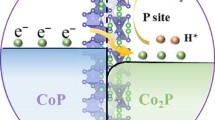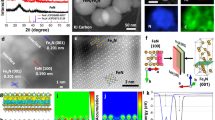Abstract
It is significant to develop highly efficient electrocatalysts for energy conversion systems. Interface engineering is one of the most feasible approaches to effectively enhance the electrocatalytic activity. Herein, the density functional theory (DFT) calculations predict that the potential barriers of Fe sites at the interface of FeP—CoP heterostructures are lower than that of Fe sites in FeP nanoparticles (NPs), Co sites in CoP NPs, or Co sites in heterostructures. Motivated by the DFT calculation results, FeP—CoP heterostructures have been designed and synthesized by a metal—organic frameworks (MOFs) confined-phosphorization method. The FeP—CoP exhibits the lowest overpotential of 230 mV at the current density of 10 mA·cm−2 for oxygen evolution reaction (OER), compared with FeP (470 mV) and CoP (340 mV), which outperforms most of transition metal-based catalysts. The Tafel analysis of FeP—CoP heterostructures shows an improved reaction kinetic pathway with the smallest slope of 90.3 mV·dec−1, as compared to the Tafel slopes of FeP NPs (137 mV·dec−1) and CoP NPs (114 mV·dec−1). And the FeP—CoP shows extraordinary long-term stability over 24 h. The excellent activity and long-term stability of FeP—CoP derive from the synergistic effect between FeP and CoP.

Similar content being viewed by others
References
Lin, B. Q.; Li, Z. Towards world’s low carbon development: The role of clean energy. Appl. Energy 2022, 307, 118160.
Yin, J.; Jin, J.; Lin, H. H.; Yin, Z. Y.; Li, J. Y.; Lu, M.; Guo, L. C.; Xi, P. X.; Tang, Y.; Yan, C. H. Optimized metal chalcogenides for boosting water splitting. Adv. Sci. 2020, 7, 1903070.
Zhou, J.; Wang, F. F.; Wang, H. Q.; Hu, S. X.; Zhou, W. J.; Liu, H. Ferrocene-induced switchable preparation of metal—nonmetal codoped tungsten nitride and carbide nanoarrays for electrocatalytic HER in alkaline and acid media. Nano Res., in press, https://doi.org/10.1007/s12274-022-4901-6.
Liu, M. M.; Li, H. X.; Liu, S. J.; Wang, L. L.; Xie, L. B.; Zhuang, Z. C.; Sun, C.; Wang, J.; Tang, M.; Sun, S. J. et al. Tailoring activation sites of metastable distorted 1T’-phase MoS2 by Ni doping for enhanced hydrogen evolution. Nano Res. 2022, 15, 5946–5952.
Jiang, J. Z.; Bai, S. S.; Yang, M. Q.; Zou, J.; Li, N.; Peng, J. H.; Wang, H. T.; Xiang, K.; Liu, S.; Zhai, T. Y. Strategic design and fabrication of MXenes-Ti3CNCl2@CoS2 core—shell nanostructure for high-efficiency hydrogen evolution. Nano Res. 2022, 15, 5977–5986.
Hu, C. L.; Zhang, L.; Gong, J. L. Recent progress made in the mechanism comprehension and design of electrocatalysts for alkaline water splitting. Energy Environ. Sci. 2019, 12, 2620–2645.
Liu, K. L.; Wang, F. M.; He, P.; Shifa, T. A.; Wang, Z. X.; Cheng, Z. Z.; Zhan, X. Y.; He, J. The role of active oxide species for electrochemical water oxidation on the surface of 3d-metal phosphides. Adv. Energy Mater. 2018, 8, 1703290.
Guo, F. J.; Zhang, M. Y.; Yi, S. C.; Li, X. X.; Xin, R.; Yang, M.; Liu, B.; Chen, H. B.; Li, H. M.; Liu, Y. J. Metal-coordinated porous polydopamine nanospheres derived Fe3N-FeCo encapsulated N-doped carbon as a highly efficient electrocatalyst for oxygen reduction reaction. Nano Res. Energy 2022, 1, e9120027.
Gong, L. Q.; Yang, H.; Wang, H. M.; Qi, R. J.; Wang, J. L.; Chen, S. H.; You, B.; Dong, Z. H.; Liu, H. F.; Xia, B. Y. Corrosion formation and phase transformation of nickel-iron hydroxide nanosheets array for efficient water oxidation. Nano Res. 2021, 14, 4528–4533.
Yu, L.; Zhou, H. Q.; Sun, J. Y.; Qin, F.; Yu, F.; Bao, J. M.; Yu, Y.; Chen, S.; Ren, Z. F. Cu nanowires shelled with NiFe layered double hydroxide nanosheets as bifunctional electrocatalysts for overall water splitting. Energy Environ. Sci. 2017, 10, 1820–1827.
Liu, G.; Gao, X. S.; Wang, K. F.; He, D. Y.; Li, J. P. Mesoporous nickel-iron binary oxide nanorods for efficient electrocatalytic water oxidation. Nano Res. 2017, 10, 2096–2105.
Zhang, L. C.; Liang, J.; Yue, L. C.; Dong, K.; Li, J.; Zhao, D. L.; Li, Z. R.; Sun, S. J.; Luo, Y. S.; Liu, Q. et al. Benzoate anions-intercalated NiFe-layered double hydroxide nanosheet array with enhanced stability for electrochemical seawater oxidation. Nano Res. Energy 2022, 1, e9120028.
Xue, Y. R.; Zuo, Z. C.; Li, Y. J.; Liu, H. B.; Li, Y. L. Graphdiyne-supported NiCo2S4 nanowires: A highly active and stable 3D bifunctional electrode material. Small 2017, 13, 1700936.
Kou, Z. K.; Wang, T. T.; Gu, Q. L.; Xiong, M.; Zheng, L. R.; Li, X.; Pan, Z. H.; Chen, H.; Verpoort, F.; Cheetham, A. K. et al. Rational design of holey 2D nonlayered transition metal carbide—nitride heterostructure nanosheets for highly efficient water oxidation. Adv. Energy Mater. 2019, 9, 1803768.
Zhang, Y. Q.; Ouyang, B.; Xu, J.; Jia, G. C.; Chen, S.; Rawat, R. S.; Fan, H. J. Rapid synthesis of cobalt nitride nanowires: Highly efficient and low-cost catalysts for oxygen evolution. Angew. Chem., Int. Ed. 2016, 55, 8670–8674.
Tang, Y.-J.; Zou, Y.; Zhu, D. D. Efficient water oxidation using an Fe-doped nickel telluride-nickel phosphide electrocatalyst by partial phosphating. J. Mater. Chem. A 2022, 10, 12438–12446.
Shan, J. Q.; Zheng, Y.; Shi, B. Y.; Davey, K.; Qiao, S.-Z. Regulating electrocatalysts via surface and interface engineering for acidic water electrooxidation. ACS Energy Lett. 2019, 4, 2719–2730.
Hu, W. P.; Zhang, H.; Salaita, K.; Sirringhaus, H. SmartMat: Smart materials to smart world. SmartMat 2020, 1, e1014.
Lee, M. Y.; Ha, H.; Cho, K. H.; Seo, H.; Park, S.; Lee, Y. H.; Kwon, S.-J.; Lee, T.-W.; Nam, K. T. Importance of interfacial band structure between the substrate and Mn3O4 nanocatalysts during electrochemical water oxidation. ACS Catal. 2020, 10, 1237–1245.
Wang, P. C.; Wang, B. G. Designing self-supported electrocatalysts for electrochemical water splitting: Surface/interface engineering toward enhanced electrocatalytic performance. ACS Appl. Mater. Interfaces 2021, 13, 59593–59617.
Yang, N. W.; Chen, D.; Cui, P. L.; Lu, T. Y.; Liu, H.; Hu, C. Q.; Xu, L.; Yang, J. Heterogeneous nanocomposites consisting of Pt3Co alloy particles and CoP2 nanorods towards high-efficiency methanol electro-oxidation. SmartMat 2021, 2, 234–245.
Cui, Y.; Guo, X. Y.; Zhang, J.; Li, X. A.; Zhu, X. B.; Huang, W. Di-defects synergy boost electrocatalysis hydrogen evolution over two-dimensional heterojunctions. Nano Res. 2022, 15, 677–684.
Yan, M. L.; Zhao, Z. Y.; Cui, P. X.; Mao, K.; Chen, C.; Wang, X. Z.; Wu, Q.; Yang, H.; Yang, L. J.; Hu, Z. Construction of hierarchical FeNi3@(Fe, Ni)S2 core-shell heterojunctions for advanced oxygen evolution. Nano Res. 2021, 14, 4220–4226.
Jiang, Y.; Li, Y. R.; Jiang, Y. M.; Liu, X. R.; Shen, W.; Li, M.; He, R. X. Interface engineering of FeCo LDH@NiCoP nanowire heterostructures for highly efficient and stable overall water splitting. Chin. Chem. Lett. 2022, 33, 4003–4007.
Zhu, Y. T.; Gao, Z. Q.; Zhang, Z. C.; Lin, T.; Zhang, Q. H.; Liu, H. L.; Gu, L.; Hu, W. P. Selectivity regulation of CO2 electroreduction on asymmetric AuAgCu tandem heterostructures. Nano Res. 2022, 15, 7861–7867.
Wei, J. M.; Zhou, M.; Long, A. C.; Xue, Y. M.; Liao, H. B.; Wei, C.; Xu, Z. J. Heterostructured electrocatalysts for hydrogen evolution reaction under alkaline conditions. Nanomicro Lett. 2018, 10, 75.
Das, P.; Fu, Q.; Bao, X. H.; Wu, Z.-S. Recent advances in the preparation, characterization, and applications of two-dimensional heterostructures for energy storage and conversion. J. Mater. Chem. A 2018, 6, 21747–21784.
Huang, Z.; Ariando; Wang, X. R.; Rusydi, A.; Chen, J. S.; Yang, H.; Venkatesan, T. Interface engineering and emergent phenomena in oxide heterostructures. Adv. Mater. 2018, 30, e1802439.
Shang, B.; Jiao, L.; Bao, Q. L.; Li, C. M.; Cui, X. Q. Strong interactions in molybdenum disulfide heterostructures boosting the catalytic performance of water splitting: A short review. Nano Mater. Sci. 2019, 1, 231–245.
Zhang, J.; Zhang, Q. Y.; Feng, X. L. Support and interface effects in water-splitting electrocatalysts. Adv. Mater. 2019, 31, 1808167.
Zhang, J.; Wang, T.; Pohl, D.; Rellinghaus, B.; Dong, R. H.; Liu, S. H.; Zhuang, X. D.; Feng, X. L. Interface engineering of MoS2-Ni3S2 heterostructures for highly enhanced electrochemical overall-watersplitting activity. Angew. Chem., Int. Ed. 2016, 55, 6702–6707.
Chen, D.; Lu, R. H.; Pu, Z. H.; Zhu, J. W.; Li, H.-W.; Liu, F.; Hu, S.; Luo, X.; Wu, J. S.; Zhao, Y. et al. Ru-doped 3D flower-like bimetallic phosphide with a climbing effect on overall water splitting. Appl. Catal. B: Environ. 2020, 279, 119396.
Guan, B. Y.; Yu, L.; Lou, X. W. A dual-metal-organic-framework derived electrocatalyst for oxygen reduction. Energy Environ. Sci. 2016, 9, 3092–3096.
Kresse, G.; Furthmüller, J. Efficiency of ab initio total energy calculations for metals and semiconductors using a plane-wave basis set. Comp. Mater. Sci. 1996, 6, 15–50.
Blöchl, P. E. Projector augmented-wave method. Phys. Rev. B 1994, 50, 17953–17979.
Perdew, J. P.; Chevary, J. A.; Vosko, S. H.; Jackson, K. A.; Pederson, M. R.; Singh, D. J.; Fiolhais, C. Atoms, molecules, solids, and surfaces: Applications of the generalized gradient approximation for exchange and correlation. Phys. Rev. B 1992, 46, 6671–6687.
Cao, X.-M.; Burch, R.; Hardacre, C.; Hu, P. An understanding of chemoselective hydrogenation on crotonaldehyde over Pt (111) in the free energy landscape: The microkinetics study based on first-principles calculations. Catal. Today 2011, 165, 71–79.
Guo, C. X.; Fu, X. Y.; Xiao, J. P. Theoretical insights on the synergy and competition between thermochemical and electrochemical steps in oxygen electroreduction. J. Phys. Chem. C 2020, 124, 25796–25804.
Exner, K. S.; Over, H. Beyond the rate-determining step in the oxygen evolution reaction over a single-crystalline IrO2 (110) model electrode: Kinetic scaling relations. ACS Catal. 2019, 9, 6755–6765.
Liu, Y. H.; Ran, N.; Ge, R. Y.; Liu, J. J.; Li, W. X.; Chen, Y. Y.; Feng, L. Y.; Che, R. C. Porous Mn-doped cobalt phosphide nanosheets as highly active electrocatalysts for oxygen evolution reaction. Chem. Eng. J. 2021, 425, 131642.
Ji, P. X.; Jin, H. H.; Xia, H. L.; Luo, X.; Zhu, J. K.; Pu, Z. H.; Mu, S. C. Double metal diphosphide pair nanocages coupled with P-doped carbon for accelerated oxygen and hydrogen evolution kinetics. ACS Appl. Mater. Interfaces 2020, 12, 727–733.
Yu, X.; Zhao, Z. X.; Pei, C. G. Surface oxidized iron-nickel nanorods anchoring on graphene architectures for oxygen evolution reaction. Chin. Chem. Lett. 2021, 32, 3579–3583.
Chen, F. H.; Zhang, Z. Q.; Liang, W. W.; Qin, X. Y.; Zhang, Z.; Jiang, L. Y. Synthesis of Co4S3/Co9S8 nanosheets and comparison study toward the OER properties induced by different metal ion doping. Chin. Chem. Lett. 2022, 33, 1395–1402.
Acknowledgements
This work was supported by the National Natural Science Foundation of China (Nos. 22101289 and 22275138), the Hundred Talents Programs in Chinese Academy of Science, the National Key Research and Development Project (No. 2021YFA1502200), the Bellwethers Project of Zhejiang Research and Development Plan (No. 2022C01158), and the Ningbo Yongjiang Talent Introduction Programme (No. 2021A-111-G).
Author information
Authors and Affiliations
Corresponding authors
Electronic Supplementary Material
12274_2023_5390_MOESM1_ESM.pdf
Designing heterostructured FeP—CoP for oxygen evolution reaction: Interface engineering to enhance electrocatalytic performance
Rights and permissions
About this article
Cite this article
Hou, S., Zhang, A., Zhou, Q. et al. Designing heterostructured FeP—CoP for oxygen evolution reaction: Interface engineering to enhance electrocatalytic performance. Nano Res. 16, 6601–6607 (2023). https://doi.org/10.1007/s12274-023-5390-y
Received:
Revised:
Accepted:
Published:
Issue Date:
DOI: https://doi.org/10.1007/s12274-023-5390-y




